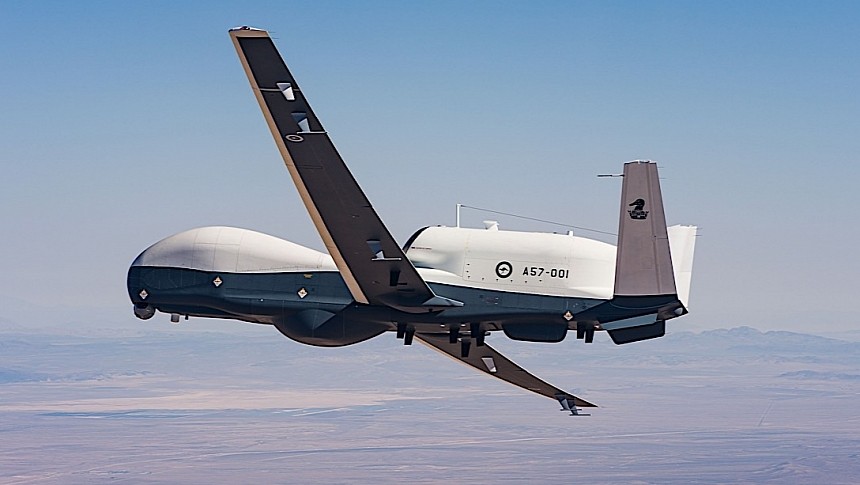A couple of months ago the U.S. Navy gave its seal of approval to the MQ-4C Triton. That would be an intelligence, surveillance, and reconnaissance (ISR) drone the likes of which the military branch has no other in operation, at least in terms of maximum altitude and endurance.
The American military has been using five such drones in recent months, as part of the Pacific Fleet. After seeing what the drone could do, the Navy declared initial operating capability (IOC) for the machine.
But the U.S. Navy will not be the only one to operate it. From the get-go the drone has been developed by Northrop Grumman to be used by the Royal Australian Air Force (RAAF) as well. And of this week, the Aussies can say they are close to getting the first example of the drone.
The American defense contractor announced it has successfully completed the first flight of the Australian version of the drone, marking a major step forward toward first deliveries, expected to take place next year.
The test flight of the machine lasted for six hours and 24 minutes, during which time a series of factors were assessed. Engineers looked at the drone's airworthiness, engine, flight controls, and fuel systems.
The MQ-4C Triton is powered by a single Rolls-Royce turbofan engine. It's a piece of hardware powerful enough to allow it to travel at speeds of up to 357 mph (575 kph).
The aircraft was designed as a dedicated "uncrewed, high-altitude, long-endurance aircraft performing persistent maritime intelligence, surveillance, reconnaissance and targeting" platform, and as such it comes with all the gear it needs to conduct its mission. That includes sensors and cameras that give it a 360-degree field of view.
The thing can cover the distance that separates New York from Sidney in a single flight, as it can stay airborne for 9,400 miles (15,000 km). That in effect allows it to scan a total surface area of 4.6 million miles (7.4 million km), about as much as that of the entire United States.
Northrop Grumman has committed to making at most 70 such drones in the first years of production, and the bulk of that will go to the U.S. Australia has so far requested only four of them, which it plans to use first and foremost as military tools, but also as aides when it comes to humanitarian and disaster relief efforts.
"Triton expands Australia's intelligence, surveillance and reconnaissance capability by providing reliable real-time intelligence and situational awareness. Persistent surveillance enables better planning, greatly enhancing joint military responses and operations," said in a statement Air Marshal Robert Chipman, Chief of the Royal Australian Air Force.
Derived from the Global Hawk drone, the Triton has an estimated cost of roughly $180 million per unit.
But the U.S. Navy will not be the only one to operate it. From the get-go the drone has been developed by Northrop Grumman to be used by the Royal Australian Air Force (RAAF) as well. And of this week, the Aussies can say they are close to getting the first example of the drone.
The American defense contractor announced it has successfully completed the first flight of the Australian version of the drone, marking a major step forward toward first deliveries, expected to take place next year.
The test flight of the machine lasted for six hours and 24 minutes, during which time a series of factors were assessed. Engineers looked at the drone's airworthiness, engine, flight controls, and fuel systems.
The MQ-4C Triton is powered by a single Rolls-Royce turbofan engine. It's a piece of hardware powerful enough to allow it to travel at speeds of up to 357 mph (575 kph).
The aircraft was designed as a dedicated "uncrewed, high-altitude, long-endurance aircraft performing persistent maritime intelligence, surveillance, reconnaissance and targeting" platform, and as such it comes with all the gear it needs to conduct its mission. That includes sensors and cameras that give it a 360-degree field of view.
The thing can cover the distance that separates New York from Sidney in a single flight, as it can stay airborne for 9,400 miles (15,000 km). That in effect allows it to scan a total surface area of 4.6 million miles (7.4 million km), about as much as that of the entire United States.
Northrop Grumman has committed to making at most 70 such drones in the first years of production, and the bulk of that will go to the U.S. Australia has so far requested only four of them, which it plans to use first and foremost as military tools, but also as aides when it comes to humanitarian and disaster relief efforts.
"Triton expands Australia's intelligence, surveillance and reconnaissance capability by providing reliable real-time intelligence and situational awareness. Persistent surveillance enables better planning, greatly enhancing joint military responses and operations," said in a statement Air Marshal Robert Chipman, Chief of the Royal Australian Air Force.
Derived from the Global Hawk drone, the Triton has an estimated cost of roughly $180 million per unit.









